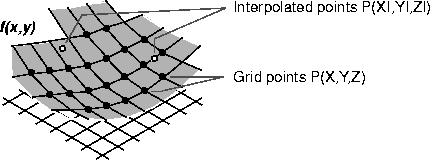
| MATLAB Function Reference | Search Help Desk |
| interp2 | Examples See Also |
Two-dimensional data interpolation (table lookup)
ZI = interp2(X,Y,Z,XI,YI)
ZI = interp2(Z,XI,YI)
ZI = interp2(Z,ntimes)
ZI = interp2(X,Y,Z,XI,YI,method)
ZI = interp2(X,Y,Z,XI,YI)
returns matrix ZI containing elements corresponding to the elements of XI and YI and determined by interpolation within the two-dimensional function specified by matrices X, Y, and Z. X and Y must be monotonic, and have the same format ("plaid") as if they were produced by meshgrid. Matrices X and Y specify the points at which the data Z is given. Out of range values are returned as NaNs.
XI and YI can be matrices, in which case interp2 returns the values of Z corresponding to the points (XI(i,j),YI(i,j)). Alternatively, you can pass in the row and column vectors xi and yi, respectively. In this case, interp2 interprets these vectors as if you issued the command meshgrid(xi,yi).
ZI = interp2(Z,XI,YI)
assumes that X = 1:n and Y = 1:m, where [m,n] = size(Z).
ZI = interp2(Z,ntimes)
expands Z by interleaving interpolates between every element, working recursively for ntimes. interp2(Z) is the same as interp2(Z,1).
ZI = interp2(X,Y,Z,XI,YI,method)
specifies an alternative interpolation method:
'linear' for bilinear interpolation (default)
'nearest' for nearest neighbor interpolation
'spline' for cubic spline interpolation
'cubic' for bicubic interpolation
X and Y be monotonic, and have the same format ("plaid") as if they were produced by meshgrid. Variable spacing is handled by mapping the given values in X, Y, XI, and YI to an equally spaced domain before interpolating. For faster interpolation when X and Y are equally spaced and monotonic, use the methods '*linear', '*cubic', '*spline', or '*nearest'.
The interp2 command interpolates between data points. It finds values of a two-dimensional function f(x,y) underlying the data at intermediate points.
tab = [NaN,Y; X,Z] and interp2 looks up the elements of XI in X, YI in Y, and, based upon their location, returns values ZI interpolated within the elements of Z.
Interpolate the peaks function over a finer grid:
[X,Y] = meshgrid(-3:.25:3); Z = peaks(X,Y); [XI,YI] = meshgrid(-3:.125:3); ZI = interp2(X,Y,Z,XI,YI); mesh(X,Y,Z), hold, mesh(XI,YI,ZI+15) hold off axis([-3 3 -3 3 -5 20])Given this set of employee data,
years = 1950:10:1990; service = 10:10:30; wage = [150.697 199.592 187.625 179.323 195.072 250.287 203.212 179.092 322.767 226.505 153.706 426.730 249.633 120.281 598.243];it is possible to interpolate to find the wage earned in 1975 by an employee with 15 years' service:
w = interp2(service,years,wage,15,1975) w = 190.6287
griddata Data gridding
interp1 One-dimensional data interpolation (table lookup)
interp3 Three-dimensional data interpolation (table lookup)
interpn Multidimensional data interpolation (table lookup)
meshgrid Generation of X and Y arrays for three-dimensional
plots.